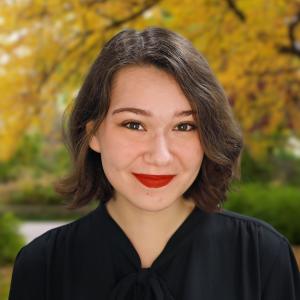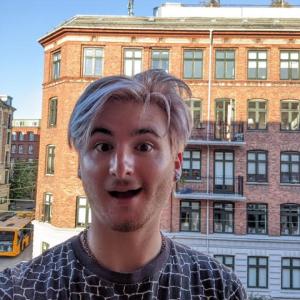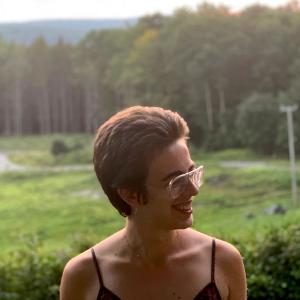Winter Term in El Salvador
February 28, 2015
Esther Espeland ’17
This winter term I had an incredible opportunity; myself and nine other Oberlin students from the organization Oberlin in Solidarity with El Salvador (OSES) traveled to the community of Santa Marta - a small town located in the mountains of northern Cabañas with whom Oberlin has had an eight-year relationship. We arrived in the capital San Salvador January 3rd, visited various historical sites for several days, and then took a three-hour bus ride to Santa Marta where we would live with host families for the next three weeks, while working in the community, learning from its people, and hearing testimonies about the civil war.
First, a brief history lesson:
El Salvador had a brutal civil war from 1980 through 1992. The central American country's quasi-feudal system had resulted in immense socioeconomic inequalities, with the majority of the nation's land being controlled by a small group of wealthy elite. Revolutionaries organized and the clash between guerrilla and government forces resulted in a 12-year-long war with 80,000 dead, 500,000 internally displaced, and 500,000 refugees in other countries. The degree of damage caused by the war was possible due to the heavy U.S. involvement. Because the uprising of revolutionaries would have conflicted with economic motives, the Reagan administration provided arms, aircraft, training for governmental forces who would massacre innocent lives, and $4 billion dollars in funds.
Before the trip we watched this documentary that provided some history about the war.
The community we visited, Santa Marta, was hit particularly hard by the war. Most residents became guerillas of the FMLN (Farabundo Martí National Liberation Front), the leftist political party of the revolution, or became refugees. In 1981, 7,500 governmental soldiers forced community members from their homes, murdering innocents, destroying their land, and forcing the survivors to flee to Honduras. Crossing the Rio Lempa, the border between El Salvador and Honduras, Santa Marteños were shot at and bombed by the Salvadoran and Honduran armies as they swam through the strong rapids. Those who survived the massacre stayed in refugee communities in honduras for six years, where they developed a system of popular education and other networks of mutual support. Upon their return to Santa Marta in 1987, they discovered their community destroyed, and essentially rebuilt their home from the ground up while the war continued around them.
In describing my winter term experience to various friends, family members, and professors, I got asked what kind of "service project" we did while in Santa Marta. However, OSES and myself believe that privileged students, specifically North Americans, visiting poor communities outside of the United States with the goal of conducting a service project can actually enact harm upon the community they intend to serve. The notion that people not belonging to a community, with little understanding of its cultural context, can enter and feel as though they have the authority to tell this community how to improve themselves, is misguided; service projects are often planned and enacted in rural areas of Latin American countries without prior consultation of the community's actual wants or needs, and are usually more for the benefit of the students visiting. North Americans can witness poverty, often for the first time, and feel as though they are "making a difference." This is problematic for many reasons: not only is it wrong to assume that these students (including myself) would know best for a self-sustaining community, this assumption is an example of the white-savior imperialism that accompanies U.S. presence in foreign countries. I've been taking a class entitled "U.S. Foreign Policy," and American service trips reflect the assumption of U.S. cultural superiority and systems of economic and political exploitation that have driven U.S. interactions with non-western countries. OSES has made fighting against these systems a priority, and we felt conducting a service project did not fit our objectives. The following address which we read as a group, while not perfect, is a good jumping-off point in discussing problems in this type of travel:
http://www.swaraj.org/illich_hell.htm
Instead, we worked at, and with, various community organizations: the greenhouse, the clinic, and the radio station to learn from the community and its people. These organizations, all long established and fully operational, did not need our help to function; we volunteered at these places to learn from their histories, their organizational structures, and to meet and befriend the people working there. Our goal in working with these organizations was to act in solidarity by supporting their work, and by amplifying the voices of the people that we worked with (some of which is done after returning to Oberlin). Working at the at the radio station, I recorded international news segments, because, as I was told, the radio listeners would find it cute to hear our gringo accents saying the news. We also did a lot of goofing around with the hilarious, brilliant young staff that worked there.

Inside the radio, this is where we would research the news.

We often hung out on the roof. This is the view - and that's a volcano in the background!
Santa Marta is an incredible community. But it's important not to glorify it as a perfect community. While there are many town structures and organizations created to support its citizens, it is still a pueblo struck by civil war; PTSD and alcoholism are common problems for the community. Although this town was essentially rebuilt by a group of incredibly strong people, war is still a deeply terrible thing that effects permanent changes on people's lives. The OSES trip is not for those seeking a vacation. Learning how your country helped fund a civil war responsible for massacring tens of thousands of people is not easy, and is necessarily an uncomfortable experience. However, it is a vital one if we are to truly work toward liberation. I was having to constantly hold myself accountable for my US passport, my whiteness, my upper-middle class background, and my reasons for occupying the space I did. I was communicating in a different language, often about very difficult subject matters, and my limits with the Spanish language were frustrating. One of the hardest things I've ever listened to in my life was the testimony of a man whose entire family and village were massacred by government soldiers, he being the lone survivor of this mass destruction of innocent lives. He was only nine years old.
But along with the struggles and experiences I heard came the inspirational strength of the people. The community organizations, set up after the war to heal and continue the fight against injustice, were examples of the collective genius of a group of highly motivated and political people, young and old. We heard stories of incredible bravery from our host families, who had already been kind enough to take us into their homes (Evila, Juve, and Paola, thank you for your stories, your patience, for teaching me and laughing with me, and for welcoming a clueless gringo into your home). I will be eternally grateful for the inspiration and friendship I found in Santa Marta.
Coming back to the US, I found it difficult to accurately describe my experience in El Salvador. Obviously Santa Marta is different from my two homes, Oberlin and Chicago. Santa Marta is a rural town in the northern mountains of El Salvador and this comes with customs and culture that are very different from what I'm used to. It could be very easy to sensationalize these differences and very often have I heard these types of descriptions from those traveling to non-Western places. Not only does focusing on these kinds of details otherize and essentialize this lifestyle, which for many people is not unusual or different, it detracts from the much more important aspects of my trip, including the people I met, the stories I heard, and the history I learned. I hope this blog post does a better job - thank you for reading.
However, a single post is nowhere near enough to accurately describe my experience in El Salvador, and more importantly its history and people. Luckily, OSES is not just a winter term trip, but an ongoing organization to maintain our relationship with this community, continue solidarity, and educate our peers about what has happened in El Salvador. One of the most important tenets of OSES as an organization is that we have a continued, ongoing relationship with Santa Marta. We accomplish this by both returning year after year and also by hosting on-campus events to repeat the stories we have heard and to amplify the voices of community members. So be on the lookout for various OSES events, speakers, and fundraisers on campus!
 We went hiking in the mountains. Photo courtesy of Lisa MacDonald.
We went hiking in the mountains. Photo courtesy of Lisa MacDonald.

OSES with our in-country coordinator and one of our host sisters. More photo cred to Lisa Macdonald.
Tags:
Similar Blog Entries

Do You Know Exactly Where Your Fingers Are??
February 9, 2024

Kosher-Halal Co-op Is Back, Baby!
February 7, 2024
